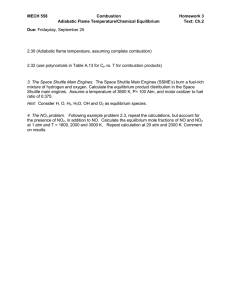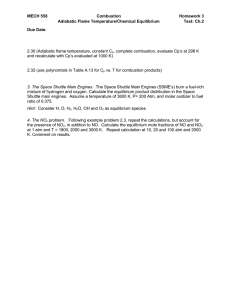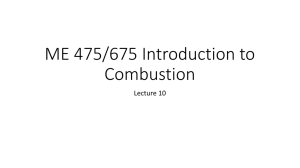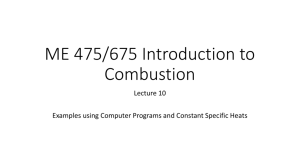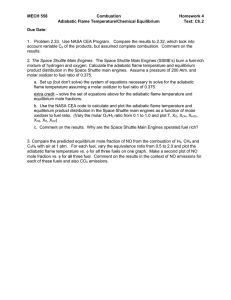EN220-Lec03-Adiabatic flame temperature and equilibrium composition of products (1)
advertisement
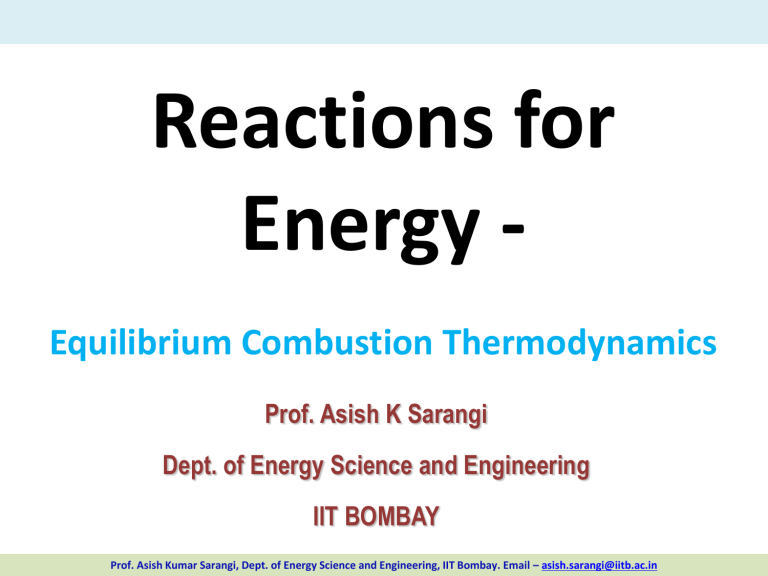
Reactions for Energy Equilibrium Combustion Thermodynamics Prof. Asish K Sarangi Dept. of Energy Science and Engineering IIT BOMBAY Prof. Asish Kumar Sarangi, Reactions Dept.for of Energy Energy.Science Department and Engineering, of Energy Science IIT Bombay. and Engineering Email – asish.sarangi@iitb.ac.in Learning objectives • Determine the adiabatic flame temperature 2 Reactions for Energy. Department of Energy Science and Engineering Adiabatic flame temperature If a fuel-air mixture burns adiabatically at constant pressure, the absolute enthalpy of the reactants at the initial state equals the absolute enthalpy of the products at the final state. 3 Reactions for Energy. Department of Energy Science and Engineering Adiabatic flame temperature Example 5: Determine the constant pressure adiabatic flame temperature for the combustion of a stoichiometric methane-air mixture. The pressure is 1 atm and the initial reactant temperature is 298 K. Use the following assumptions. a. Complete combustion i.e., the product mixture consists of only CO2, H2O and N2. b. The product mixture enthalpy is estimated using constant specific heats evaluated at 1200 K, where Tad is guessed to be 2100 K. 4 Reactions for Energy. Department of Energy Science and Engineering Adiabatic flame temperature (5) Dissociation of products at high temperature at ambient pressure: Example: The space shuttle burns H2 and O2 in the main engine. To estimate the maximum flame temperature, let’s consider combustion of 1 mol of gaseous H2 with ½ mol of gaseous O2 at STP. Determine the adiabatic flame temperature. 5 Reactions for Energy. Department of Energy Science and Engineering Equilibrium composition of products Example 3: In fuel rich combustion products mixtures, equilibrium between the species CO2, H2O, CO and H2 is often assumed to determine the burned gas composition. For Φ=1.2, for C8H18-air combustion products, determine the mole fractions of the product species at 1700 K. 6 Reactions for Energy. Department of Energy Science and Engineering Background on equilibrium calculation Thermodynamics of combustion shows that if we know the initial state of a reactive gas mixture, the final state of the mixture after chemical equilibrium can be determined. But the chemical equilibrium calculation does not tell us - How does the mixture get from initial state to final state? - How long does it take to complete the reaction? Example: The equilibrium constant of the reaction at 298 K is 1040 H2+O2 H2O 7 Reactions for Energy. Department of Energy Science and Engineering Next Lecture ▪ Chemical kinetics 8 Reactions for Energy. Department of Energy Science and Engineering
